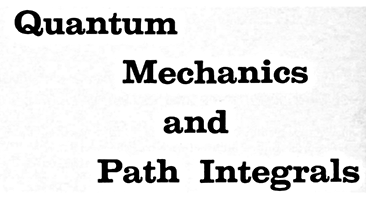
\(\)
Problem 9-8
For the state for which there is just one photon present in level \(\def\mb#1{\mathbf{#1}}1\mb{k}\), all of the factors in the wave function are \(\phi_0\) except one, which is \(\phi_1\). But for an oscillator \(\displaystyle{\phi_1(x)=\sqrt{\frac{2m\omega}{\hbar}}\,x\,\phi_0(x)}\). The wave function representing an excited running wave is a linear superposition of the state with the cosine mode excited and \(i\) times the state with the sine wave excited, so show that the wave function for just one photon present in state \(1\mb{k}\) is \(\varPhi_1=a^{*}_{1\mb{k}}\varPhi_0\). This is not normalized. The normalization is \(\langle \varPhi_1 | \varPhi_1 \rangle=\langle\Phi_0 | a_{1\mb{k}}a^{*}_{1\mb{k}} | \varPhi_0\rangle\), or the expectation of \(a_{1\mb{k}}a^{*}_{1\mb{k}}\) for a vacuum, which we have seen in the preceding problem is \(\displaystyle{\frac{\hbar}{2kc}}\). Hence the normalized one-photon state is \(\displaystyle{\sqrt{\frac{2kc}{\hbar}}\,a_{1\mb{k}}^{*}\varPhi_0}\).
( 解答 ) 式 (8-17) と式 (8-19) および問題 8-4 の式 (5) から,
\def\pdiff#1{\frac{\partial}{\partial #1}}
\def\reverse#1{\frac{1}{#1}}
\def\Bppdiff#1#2{\frac{\partial^{2} #1}{\partial #2^{2}}}
\def\ppdiff#1#2{\frac{\partial #1}{\partial #2}}
\def\BK#1#2{\langle #1 | #2 \rangle}
\def\BraKet#1#2#3{\langle #1 | #2 | #3 \rangle}
&\phi_0(x)=\left(\frac{m\omega}{\pi\hbar}\right)^{1/4}\exp\left(-\frac{m\omega}{2\hbar}x^{2}\right),\quad
\phi_1(x)=\left(\frac{2m\omega}{\hbar}\right)^{1/2}x\,\phi_0(x)\equiv A_1\,x\,\phi_0(x)\tag{1}\\
&\varPhi_0=A\phi_0\phi_1\dotsb\phi_{N-1}=A\prod_{\alpha=0}^{N-1}\exp\left(-\frac{\omega_{\alpha}}{2\hbar}
Q_{\alpha}^{\,*}Q_{\alpha}\right)=A\exp\left(-\frac{1}{2\hbar}\sum_{\alpha=0}^{N-1} \omega_{\alpha}Q_{\alpha}^{\,*}Q_{\alpha} \right),\tag{2}\\
&\phi_{\alpha}=\phi_0(Q_{\alpha})
=A_{\alpha}\exp\left(-\frac{\omega_{\alpha}}{2\hbar}Q_{\alpha}^{\,*}Q_{\alpha}\right)
\tag{3}
\end{align}
式 (1) の \(\phi_0(x)\) と式 (3) の \(\phi_{\alpha}\) との比較から, 次の対応関係になっていることが分かる:
m\omega\rightarrow\omega_{\alpha}=kc,\quad x^{2}\rightarrow Q_{\alpha}^{\,*}Q_{\alpha},\quad (\, x\rightarrow Q_{\alpha}\quad
\mathrm{or}\quad x\rightarrow Q_{\alpha}^{\,*}\, )
\tag{4}
\end{equation}
ここでは問題に合わせて \(x\to Q_{\alpha}^{\,*}\) とする.また式 (9-43) から「\(\omega_{\alpha}=kc\)」である.すると, 振動子の \(\phi_1(x)\) に相当する基準座標の波動関数 \(\phi_1(Q_{\alpha})\) は, 同じ対応関係であるとして次に書けるであろう:
\phi_1(x)=A\,x\,\phi_0(x)\ \rightarrow\
\phi_1(Q_{\alpha})=A\,Q_{\alpha}^{\,*}\,\exp\left(-\frac{\omega_{\alpha}}{2\hbar}Q_{\alpha}^{\,*}Q_{\alpha}\right)
=A\,Q_{\alpha}^{\,*}\,\phi_0(Q_{\alpha}),\quad \phi_1^{\,*}(Q_{\alpha})=A^{*}\phi_0^{\,*}(Q_{\alpha})\,Q_{\alpha}
\tag{5}
\end{equation}
さて, 基底状態 \(\varPhi_0\) に於いてモード \(\alpha\) の振動子だけが励起されて \(\phi_1(Q_{\alpha})\) となったときの系全体の状態を \(\varPhi_1\) としよう.式 (5) から \(\phi_1(Q_{\alpha})=A\,Q_{\alpha}^{\,*}\phi_0(Q_{\alpha})\) なので, この励起状態 \(\varPhi_1\) は次のように表されるであろう:
\varPhi_1 &=\phi_0(Q_0)\phi_0(Q_1)\dotsb\phi_1(Q_{\alpha})\dotsb\phi_0(Q_{N-1})\notag\\
&=\phi_0(Q_0)\phi_0(Q_1)\dotsb A\,Q_{\alpha}^{\,*}\phi_0(Q_{\alpha})\dotsb\phi_0(Q_{N-1})\notag\\
&=A\,Q_{\alpha}^{\,*}\,\phi_0(Q_0)\phi_0(Q_1)\dotsb \phi_0(Q_{\alpha})\dotsb\phi_0(Q_{N-1}),\notag\\
\therefore\quad \varPhi_1 &=A\,Q_{\alpha}^{\,*}\,\varPhi_0
\tag{6}
\end{align}
この波動関数 \(\varPhi_1\) の規格化定数 \(A\) を求めるには, 問題 8-5 の真空すなわち基底状態の遷移要素, つまり「期待値」: \(\BraKet{\varPhi_0}{Q_{\alpha}^{\,*}Q_{\alpha}}{\varPhi_0}\) を利用することが出来る:
\BK{\varPhi_1}{\varPhi_1}&=\int dQ_0\dotsb \int dQ_{N-1}\,\varPhi_1^{*}\,\varPhi_1\notag\\
&=\int dQ_0\dotsb \int dQ_{N-1}\,A^{*}Q_{\alpha}\phi_0^{*}(Q_0)\phi_0^{*}(Q_1)\dotsb \phi_0^{*}(Q_{\alpha})\dotsb\phi_0^{*}(Q_{N-1})A\,Q_{\alpha}^{\,*}\,\phi_0(Q_0)\phi_0(Q_1)\dotsb \phi_0(Q_{\alpha})\dotsb\phi_0(Q_{N-1})\notag\\
&=|A|^{2}\int dQ_{0}\phi^{*}_0(Q_0)\phi_0(Q_0)\int dQ_{1}\phi^{*}_0(Q_1)\phi_0(Q_1)\dotsb
\int dQ_{\alpha}\phi^{*}_0(Q_{\alpha})Q_{\alpha}Q^{*}_{\alpha}\phi_0(Q_{\alpha})\dotsb
\int dQ_{N-1}\phi^{*}_0(Q_{N-1})\phi_0(Q_{N-1})\notag\\
&=|A|^{2}\int dQ_{\alpha}\phi^{*}_0(Q_{\alpha})Q_{\alpha}Q^{*}_{\alpha}\phi_0(Q_{\alpha}),
\tag{7}
\end{align}
または,
\BK{\varPhi_1}{\varPhi_1}
&=\int dQ_0\dotsb \int dQ_{N-1}\,A^{*}\,\varPhi_0^{*}Q_{\alpha}\cdot A\,Q_{\alpha}^{*}\varPhi_0\notag\\
&=|A|^{2}\BraKet{\varPhi_0}{Q_{\alpha}^{*}Q_{\alpha}}{\varPhi_0}\notag\\
&=|A|^{2}\frac{\hbar}{2\omega_{\alpha}}\BraKet{\varPhi_0}{1}{\varPhi_0}=1
\tag{8}
\end{align}
フォトンの場合,「基準座標 \(Q_{\alpha}\) として \(a_{1\mb{k}}\) を採用する」ことが出来るのであった.従って,「状態 \(1\mb{k}\) にちょうど1個のフォトンが存在する規格化された\(1\)光子状態状態 \(\varPhi_1\)」の規格化は, 「基底状態の波動関数 \(\varPhi_0\) は規格化されている」とするならば, 上式(7) や式 (8) より次のようにして求めることが出来る:
\BK{\varPhi_1}{\varPhi_1}=|A|^{2}\int \phi^{*}_0(a_{1\mb{k}})\,a_{1\mb{k}}a^{\,*}_{1\mb{k}}\,\phi_0(a_{1\mb{k}})\,da_{1\mb{k}}
=|A|^{2}\frac{\hbar}{2kc}\BraKet{\varPhi_0}{1}{\varPhi_0}=|A|^{2}\frac{\hbar}{2kc}=1,\ \therefore\
A=\sqrt{\frac{2kc}{\hbar}}
\tag{9}
\end{equation}
従って, 波動関数 \(\varPhi_1\) は, 式 (6) から次とすることが出来る:
\varPhi_1 =A\,Q_{\alpha}^{*}\varPhi_0 \ \rightarrow\ \varPhi_1 =\sqrt{\frac{2kc}{\hbar}}\,a_{1\mb{k}}^{\,*}\,\varPhi_0
\tag{10}
\end{equation}
